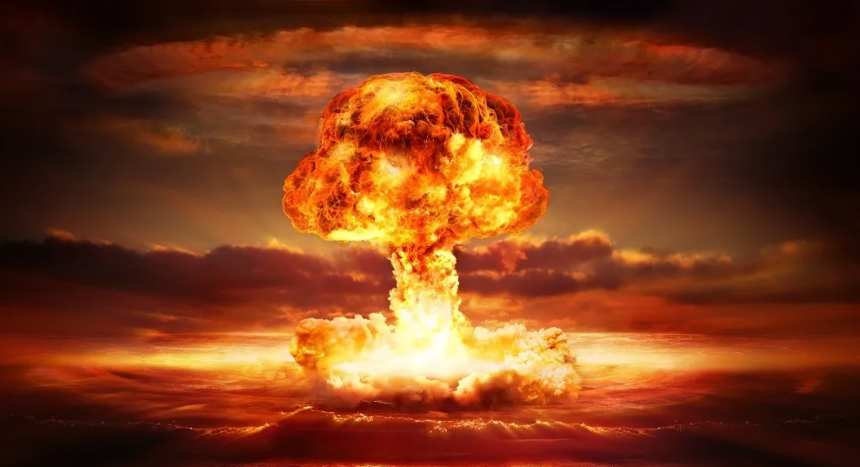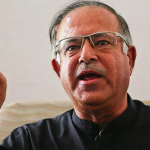Nuclear weapons are the most destructive and inhumane weapons ever developed on earth. Their use by anyone at any time, whether by accident, miscalculation or design, would be catastrophic. They are the only weapons ever conceived that have the capacity to wholly destroy life on this planet.
July 16, 1945 was the most inauspicious day in the history of mankind when the world’s first atomic bomb, nicknamed Gadget, containing 13 pounds of plutonium, built under the banner of Manhattan project by USA under the leadership of Colonel Groves and Robert Oppenheimer, a physicist and Professor at the University of California, detonated in the New Mexican desert, releasing enormous energy equivalent to 21,000 tons of TNT and creating a fireball that measured roughly 2,000 feet in diameter, temporarily blinding observers standing even 10,000 yards away, and melting the sand and steel in the area.
This first successful test of an atomic bomb, known as Trinity Test, with a destructive power unknown to the entire humanity, forever changed the history of the world. The successful test of the ‘Gadget’ with destructive results beyond the imagination of its makers while sowing the seeds of dominance, colonialism, interventionism and dictatorship in the mind of US leadership, crippled other nations through development of insecurity and fear.
After noting the mind blowing results of this destructive bomb, the United States not only pursued its mission to attain military might but also demonstrated it in August 1945 by finally dropping 2 atomic bombs, nicknamed as ‘Little Boy’ and ‘Fat Man’ on Hiroshima and Nagasaki, the two promising and prosperous cities of Japan, culminating WW II, and killing more than 2 lakh people without remorse. History will never forgive President Harry Truman of USA, for ordering this bombing that shattered Japan besides triggering an unending race for nukes.
The number of nuclear warheads kept on increasing at global level and reached its peak in 1985-86 with a frightening figure of ca. 70,000 followed by a steady decline. Their number started declining substantially with the end of the cold water, however, ICNND report (2009) says that that there were about 23000 nuclear warheads in existence even two decades after the end of cold war, with a combined blast capacity equivalent to 150,000 Hiroshima bombs. The Russia and the US together had over 22000 and France, UK, China, India, Pakistan and Israel around 1,000 between them. The nuclear powers reduced their arsenals to almost half in the following decades.
Today, nine countries of the world (USA, Russia, France, China, UK, Israel, India, Pakistan and North Korea) have a total of more than 12000 nuclear warheads with 90% of them belonging to USA and Russia alone (Federation of American Scientists 2025). Of these around 10000 are in military stockpiles for use by missiles, aircrafts, ships and submarines. Approximately 2100 warheads of USA, Russia, UK and France on ballistic missiles are on alert and can be launched on short notice (Estimated Global Nuclear Warhead Inventories 2025).
It is very important to mention that Israel is the undeclared nuclear power with about 90 nuclear warheads. It started work on its N-weapons programme within years of the founding of the Jewish nation with the clandestine help of Uranium-rich South Africa. France, grateful to Israel for its role in the joint invasion of Egypt, became its crucial diplomatic and technological partner in accomplishing the mission leading to becoming nuclear power. Only one country that had them – South Africa – entirely dismantled their arsenals.
The right to possess these weapons is an issue of serious contention in the international community. The most comprehensive Nuclear Non-proliferation Treaty of 1968 (NPT) consists of a pledge by current nuclear weapon states to reduce their nuclear stockpiles and achieve nuclear disarmament in return for non-nuclear weapon states not developing such weapons. NPT is applied strictly on non-nuclear weapon states and every effort is made not to allow proliferation but when it comes to reduction of nuclear warheads by the nuclear states, the picture is gruesome.
USA is reportedly decreasing the size of its nuclear stockpiles, although at a snail’s pace, but Russia, UK and a few other countries are increasing. If Russia and United States each pledge to destroy 500 nuclear warheads in a year, it will take them more than 10 years to descend to the level of India’s nuclear arsenal stock.
Whether nuclear weapons are for deterrence or dominance is a complicated topic. Apparently, they have proved deterrent when nuclear-nuclear are the players but dominant when conflict happened between nuclear and non-nuclear states. India-China and India-Pakistan conflicts have been deterred to escalate by nuke possession, whereas in Russia-Ukraine and Israel-Palestine War it has acted otherwise.
Recently, Israel targeted Iran, later joined by USA, on the pretext that Iran is enriching Uranium for making nuclear weapons which the later denied with the argument that their nuclear plants are for peaceful use, the whole world with exception of a few countries turned mute either due to their vested interests or due to fear. If Israel, with a meagre population of 95 lakhs and a geographical area of just 22000 square Km (1/150th of India) has a right to have nuclear warheads, why not Iran or any other country? We are not against NPT but it should not be discriminatory.
Possession of nuclear weapons besides boosting confidence and sense of security and pride in a nation, turns it arrogant with dictatorial attitude. Such State Heads become drunk with power. Their every word becomes an order and every action, how non-sense it may be, legitimate. They look down upon poorer and non-nuclear nations.
In February 2025 President Donald Trump, berated his Ukrainian counterpart V.Zelensky in a meeting in White House tarnishing all protocols. The visiting guest was almost kicked out of the Oval Office by Trump and his deputy JD Vance. A similar treatment was given to South African President Cyril Ramaphosa in a White House meeting in May 2025. It appears that President Trump runs press conferences, especially when guests from poorer nations are involved, like WWE cage and choreographed matches.
Following World War II, the United States emerged as a global superpower vis-à-vis the Soviet Union (now Russia) in the Cold War. It provided foreign military aid and even got directly involved in proxy wars against the Soviet Union. It was the principal foreign actor in the Korean War and Vietnam War during this era of almost forty years. Following September 11, 2001 attacks on World Trade Centre the United States and its allies fought in Afghanistan for two decades.
Using all kinds of heavy and lethal weaponry including cluster bombs, the US and its allied partners killed more than 50000 Afghani civilians and about 80000 Taliban insurgents. It fought with Iraq in 1991 to drive it out from Kuwait which was invaded by Saddam Hussain. To destroy weapons of mass destruction possessed by Iraq, as falsely claimed by US, it again fought against Iraq along with its allies for more than eight years that killed over a million people including 100000 civilians.
The US has incurred a whooping amount of $5.8 trillion in the Middle East and Afghanistan wars. To maintain its military superiority and dominance in the world, the US on an average spends almost double than China and Russia taken together on military. In 2024 it spent $997bn on military as compared to China and Russia who spent $314bn and 149bn respectively.
Russia has been waging a war with Ukraine since February 2022. Fighting and air strikes have inflicted over 40000 civilian causalities while 3.7 million people are internally displaced. Having already seized Ukraine’s Crimea peninsula eight years ago after a revolution that ousted Ukraine’s pro-Russian President and replaced him with a more pro-western government, Putin has captured about one-fifth of Ukraine in the last three years of war.
Israeli onslaught on Palestine is the worst example of might. It began in October 2023 killing at least 50000 people in Gaza including 18000 children in 18 months. In addition to confirmed causalities thousands of people are feared buried under the rubble. More than one lakh people have been injured including 4500 amputations and hundreds of thousands are suffering from hunger and lack of medical facilities.
An estimated 85000 tonnes of explosives have been dropped in Gaza according to Environmental Quality Authority of Palestine. The whole world, except a few, is mute spectator due to vested interests and military might of Israel and its big brother – the United States. Richard Rhodes is the Pulitzer Prize-winning author of the book ‘The Making of the Atomic Bomb’. The book shows up the nuclear hawks for what they are nuclear drunks who worship nuclear weapons and become their prisoners.
India has always been a strong advocate of complete disarmament, which it believes is the only way to peace and prosperity. Jawaharlal Nehru in 1954 tried his best to get the CTBT ratified by all the member countries, at least to save the earth from radiation hazards. Addressing the United Nations General Assembly on June 9, 1988, Rajiv Gandhi appealed, “Nuclear war will not mean the death of a hundred million people or even a thousand million. It will mean the extinction of four thousand million: the end of life as we know it on our planet earth. We come to the United Nations to seek your support. We seek your support to put a stop to this madness.”
Access to affordable, reliable, sustainable and clean energy is one of the 17 SDGs that the member nations in UN General Assembly in 2015 have pledged to achieve by 2030. For many decades fossil fuels such as coal, oil or gas have been major sources of energy but burning such fuels produces large amounts of greenhouse gases which cause climate change and have harmful impacts on people’s well-being and the environment.
Therefore, to achieve the desired results all the nations have to increase investments in renewable energy like solar, wind, geothermal and hydroelectric sectors besides taking a leap in civil nuclear energy. Nuclear fuel is a source of energy that can provide electricity without emitting greenhouse gases but there is a need for close surveillance to discourage weapons’ grade enrichment of fissile material especially Uranium-235 and Plutonium-239 by all the nations.
To meet growing energy demands and reducing dependency on fossil fuels to achieve environmental goals India is actively enhancing its nuclear power capacity. The government has initiated steps to increase nuclear power capacity from the current 8,180 MW to 22,480 by 2031-32. The Union Budget 2025-26 outlines a significant push towards nuclear energy as part of India’s long-term energy transition strategy.
The whole world is fighting against poverty, hunger, malnutrition especially those of children, diseases like diabetes and cancer and those of heart, kidney, and respiratory tract, scarcity of hygienic and portable water, biodiversity loss, pollution and climate change. Around 735 million people (9.2% of world’s population) are facing chronic hunger and two billion people do not have regular access to safe, sufficient and nutritious food.
More than 8.4% of the world’s population are still living in extreme poverty (UNO). There is dire need to pump a sizeable proportion of GDP by every nation in all those sectors which are directly or indirectly linked to above challenges. However, a big chunk of resources goes towards defence augmentation. A recent report by ICAN indicates that annual global spending on nuclear weapons by nine nuclear armed states has exceeded $100 billion in 2024 which includes spending on research, development, maintenance, and storage with 50% of it spent by United States alone.
With great power comes great responsibility. Harnessing nuclear energy poses serious risks to human and environmental health, especially when accidents occur. Nuclear accidents can release large amounts of radioactive material into the atmosphere, soil, and water, causing radiation exposure, contamination, and cancer. Six of the worst nuclear disasters that ever happened, based on their rating on the International Nuclear and Radiological Event Scale (INES), which measures the severity and impact of nuclear events include Chernobyl (1986), Fukushima (2011), Kyshtym (1957), Windscale (1957), Three Mile Island (1979), and Church Rock (1979).
Chernobyl was a level 7 disaster that occurred in Ukraine and is considered the worst nuclear disaster in history. A faulty reactor design and human error caused a massive explosion and fire killing 31 people directly and exposed millions more to radiation. It is estimated that about 4000 people died from cancer and other diseases caused by the radiation and forced evacuation and relocation of hundreds of thousands of people from the contaminated areas, and left a large exclusion zone that remains uninhabitable even today.
Although the possibility of unauthorized use of strategic weapons as a result of technical malfunction or human act is very small, there is a significant and continuing fear internationally of nuclear terrorism. Hence complete nuclear disarmament is the only solution. The nuclear nations have to destroy their much cherished nuclear coffins, made by them for the entire mankind, as early as possible, otherwise no one would be left alive even to collect their ashes and non-nuclear nations have to abstain from any such effort leading to formation of nuclear warheads.
(Author is Principal (Rtd.) J&K Higher Education Department. Email: [email protected])
Nuclear Weapons: Catastrophic devices for deterrence or dominance
India has always been a strong advocate of complete disarmament, which it believes is the only way to peace and prosperity

Leave a Comment
Leave a Comment








